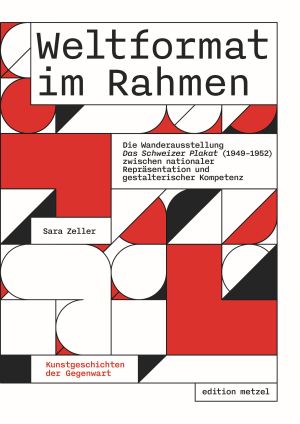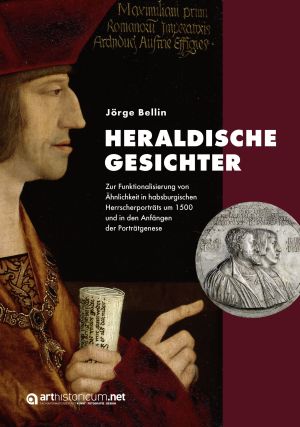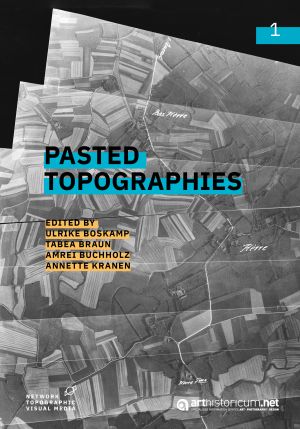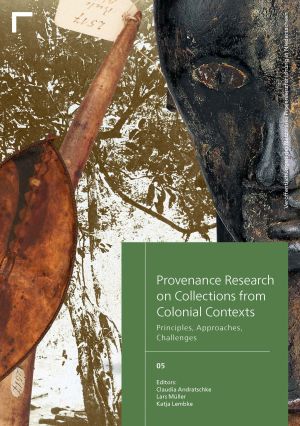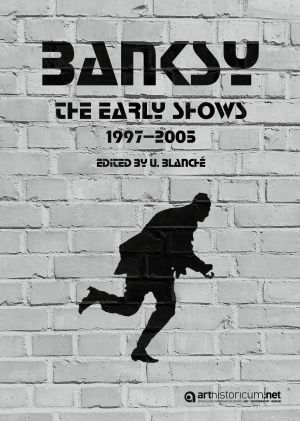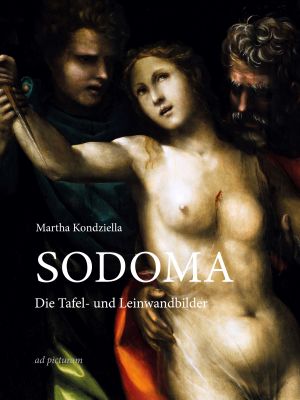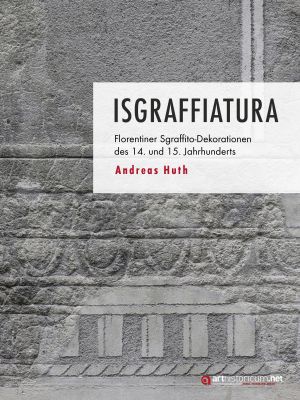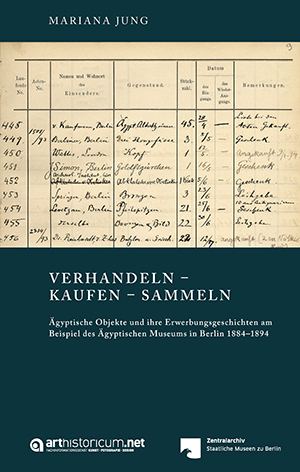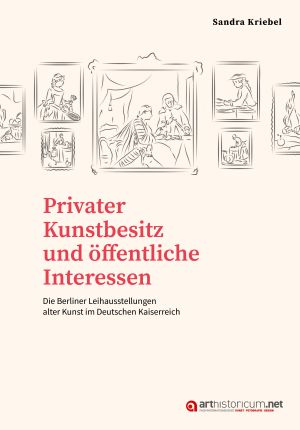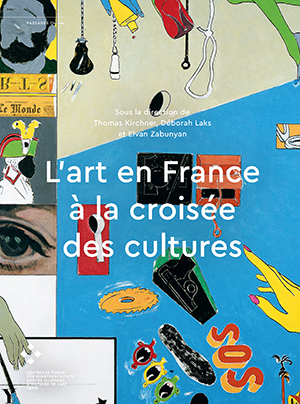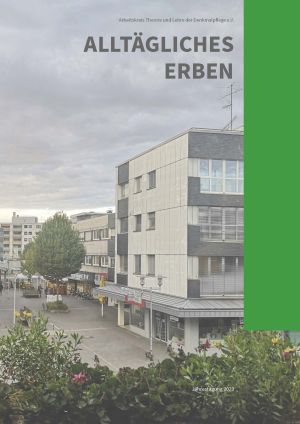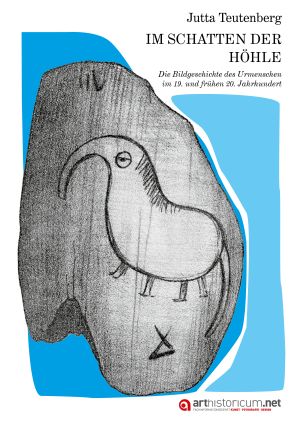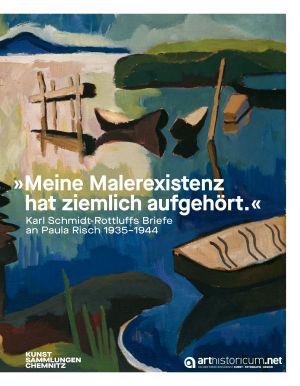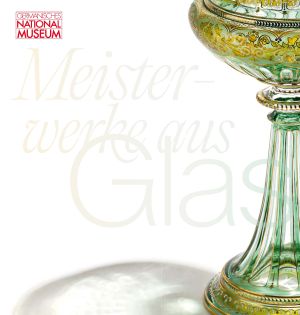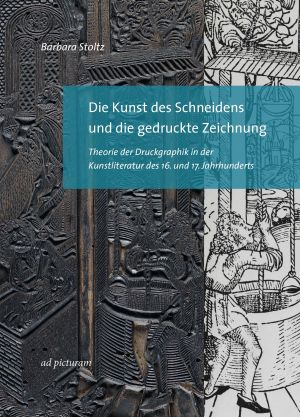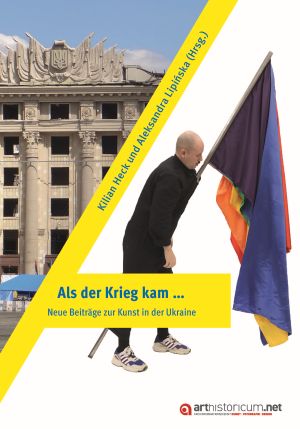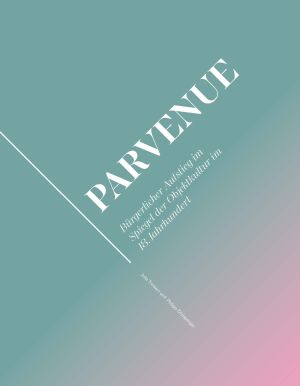Bücher
Weltformat im Rahmen: Die Wanderausstellung Das Schweizer Plakat (1949–1952) zwischen nationaler Repräsentation und gestalterischer Kompetenz
Die Wanderausstellung "Das Schweizer Plakat" zirkulierte zwischen 1949 bis 1952 durch Europa und Amerika. Als kulturdiplomatische Manifestation erfüllte die Plakatausstellung von Pro Helvetia eine strategische Funktion, indem sie nationale Werte mittels Gestaltung vermitteln sollte, in einer Zeit, in der sich die politische Weltordnung neu formierte. Gleichzeitig trug die Ausstellung massgeblich dazu bei, das mittlerweile UNESCO-anerkannte Label Schweizer Grafikdesign zu stilisieren und etablieren, was in der Historiographie der Fachdisziplin bisher außer Acht gelassen wurde.
Heraldische Gesichter: Zur Funktionalisierung von Ähnlichkeit in habsburgischen Herrscherporträts um 1500 und in den Anfängen der Porträtgenese
Für Jakob Burckhardt gehörte „die Frage, wie weit Porträt? wie weit Ideal? […] zu den anmuthigsten Fragen der italienischen Kunstgeschichte“. Sie ist tatsächlich nicht nur ein zentrales Problem der italienischen, sondern der gesamteuropäischen Porträtgenese und ihrer Erforschung. Gerade im Hinblick auf Herrscherbildnisse wurde dabei der für Begriff und Sache des Porträts elementare Aspekt physiognomischer Ähnlichkeit (similitudo) immer wieder marginalisiert, trat das „Individuum“ hinter „Typus“, „Ideal“ und „höherer Auffassung“ zurück. Die vorliegende Untersuchung setzt diesem nur scheinbaren Gegensatz ein am Konzept der similitudo orientiertes Interpretationsmodell entgegen, das die nachantike ‚Wiederentdeckung‘ der Ähnlichkeit als einen ebenso bedeutenden wie effektiven Faktor der politischen Semiotik begreift.
Pasted Topographies
Medial erzeugte Vorstellungen von Raum werden vielfach erst durch Techniken des Klebens ermöglicht. Die Fallstudien des Bandes untersuchen einerseits Praktiken des Zusammenfügens bei der Produktion topografischer Bildmedien, etwa das Aneinanderkleben von Einzelbildern oder das Montieren von Papieren zu größeren Bögen. Solche Klebevorgänge lassen sich als Antwort auf die Herausforderungen topografischer Erschließung und Darstellung von Räumen verstehen. Andererseits werden Verfahren der Collage bzw. Assemblage im Gebrauch und in der Aufbereitung topografischer Bildmedien analysiert. Diese sind häufig zu Verbundmedien zusammengestellt, mit denen Räume in ihrer Komplexität oder schieren Ausdehnung medial eingefangen werden sollen. Die unterschiedlichen Formen des Montierens von Bildern, etwa in Klebebänden, Reiseaufzeichnungen, Atlanten, Serien oder der Kopplung von Bildfolge und Karte, ermöglichen in diesen Fällen das Kombinieren, sequenzielle Darstellen, Layern und Kontextualisieren von Räumen.
Provenance Research on Collections from Colonial Contexts: Principles, Approaches, Challenges
Der Band versammelt die Beiträge der gleichnamigen internationalen Konferenz, die im Juni 2021 in der Leibniz Universität Hannover veranstaltet wurde. Die Konferenz wurde von dem am Landesmuseum Hannover koordinierten Verbundprojekt „Provenienzforschung zu außereuropäischen Sammlungen und der Ethnologie in Niedersachsen“ (PAESE) geplant. Ziel war es, Akteur*innen aus unterschiedlichen Perspektiven zusammenzubringen, um Fragen, Methoden und (vorläufige) Ergebnisse im Bereich der Provenienzforschung zu Sammlungsgut aus kolonialen Kontexten zu diskutieren.
Materialität im Kontext: Studien zur Kunsttechnik spätmittelalterlicher Tafelmalerei aus Bayern, Österreich und Südtirol am Germanischen Nationalmuseum. Ausgewählte Ergebnisse des kunsttechnologischen Forschungsprojektes
Technologische Kartierungen und Umzeichnungen von Josefine Kramer
Seit 2013 erforscht das Germanische Nationalmuseum in Nürnberg seinen umfangreichen Bestand spätmittelalterlicher Tafelmalerei in beispielhafter Weise. Zwischen 2019 und 2022 standen die 26 Tafelgemälde aus Altbayern, Österreich und Südtirol im Mittelpunkt eines ausschließlich kunsttechnologisch orientierten Forschungsprojektes am Institut für Kunsttechnik und Konservierung im Rahmen des BMBF geförderten Schwerpunktprogramms „Kleine Fächer – Große Potenziale“. Die Publikation, mit der das Forschungsprojekt „Materialität im Kontext“ seinen Abschluss findet, bietet eine Zusammenschau ausgewählter Ergebnisse des Projektes, eingebettet in den Kontext der aktuellen Forschung. Die reich bebilderte Publikation erscheint open access sowohl im PDF- als auch HTML-Format und eröffnet damit neue Wege hinsichtlich Abbildungsqualität und Vernetzung von Inhalten.
Banksy: The Early Shows. 1997-2005
"Die frühen Ausstellungen" zeichnet Banksys anfängliche künstlerische Entwicklung vom Tagger und Musikeventgrafiker zum Schablonen-Street Artist nach. Der heute prominente Banksy erlangte ab 2006 weltweite Bekanntheit. Danach schuf er seine Werke vor den Augen der Welt. Eher obskur sind jedoch seine Ausstellungen vor 2003, als er in Großbritannien mit der selbst organisierten Retrospektive Turf War und seinem Albumcover-Design für die BritPop-Band Blur den Durchbruch schaffte. Dieser Überblick, herausgegeben vom Banksy-Experten Ulrich Blanché, umfasst frühe Banksy-Ausstellungen und -Veranstaltungen von 1995 bis 2005. Sie versteht sich als akademisches Gegenstück zu Banksys Künstlerbuch Wall and Piece (2005), das sich hauptsächlich auf seine illegalen Straßenarbeiten bis dahin konzentrierte.
Das Sehbare und das Unsehbare: Teil 3: Abenteuer der Bildanschauung – Caravaggios Enthauptungen des Johannes
Dieses Buch ist ein Plädoyer für eine intensive Betrachtung von Gemälden. Mit den hier vorliegenden Analysen tauchen wir in die ungeheuer vielgestaltige Bildwelt des Malers Caravaggio ein.
Ein Abenteuer, das auch deshalb ein besonders verlockendes Wagnis ist, weil es darum geht, sich ganz auf die eigene ästhetische Erfahrung einzulassen. Erst und nur in der konkreten Bildanschauung begegnen wir dem tieferen Sinn der eigenbedeutsamen Bildphänomene in den Gemälden. »Den Wert der Malerei erblicken wir«, so formulierte es der Kunsthistoriker Theodor Hetzer früher einmal euphorisch und pathetisch, »im Zauber ihrer Möglichkeiten«.
Die Leserinnen und Leser sind eingeladen zu einer rezeptionsästhetischen und phänomenologischen Reise durch großartige Bildlandschaften der frühen Neuzeit.
Dabei stehen hier Caravaggios Bildlösungen im Zusammenhang mit der Enthauptung des Johannes im Mittelpunkt des Interesses.
Sodoma: Die Tafel- und Leinwandbilder
Trotz seines Einflusses auf Sienas Kunstszene zählt Giovanni Antonio Bazzi, genannt Sodoma, zu den eher vernachlässigten Renaissancemalern. Bisher beschäftigte sich die Forschung vor allem mit seinen Fresken. Diese Publikation setzt sich erstmals eingehend mit Sodomas Tafel- und Leinwandbildern auseinander, analysiert seine künstlerische Entwicklung, seinen Umgang mit Einflüssen, seine Arbeitsweise und beantwortet Fragen zur Werkgenese. Zudem liefert sie einen umfassenden Werkkatalog, der Sodomas Tafel- und Leinwandbilder mit zugehörigen Zeichnungen erfasst. Somit ebnet diese Untersuchung den Weg für weiterführende Studien zu Sodoma und bringt ihn zurück in den kunstwissenschaftlichen Diskurs.
Anhänger in Buchform: Eine Geschichte des europäischen Schmucks (1450—1650)
Mit der Verbreitung des Buchdrucks entstehen in Europa ab der Mitte des 15. Jahrhunderts kostbare Schmuckstücke, die als Bücher in Miniaturform gestaltet sind. Sie sind nur wenige Zentimeter groß und mit Buchrücken, Buchschnitt und Schließen versehen. Doch es handelt sich in der Regel nicht um Verkleinerungen ‚richtiger Bücher‘: Statt bedruckter oder beschriebener Pergamentblätter bergen die Anhänger in ihrem Inneren meist bebilderte Metallblätter oder fungieren als Behältnis z.B. für Reliquien.
Die repräsentativen Schmuckstücke dienten ihren Träger:innen als Statussymbol, drückten ihre humanistische Gesinnung und Belesenheit aus, aber konnten auch ein konfessionelles Statement sein. Zugleich waren sie oft ein Mittel der individuellen Andacht und Glaubensvergewisserung oder versprachen als wirkmächtiges Amulett Schutz.
In ihrer Studie legt Romina Ebenhöch erstmals einen Katalog dieser besonderen Gattung von Schmuckanhängern vor und analysiert die Funktion der Objekte.
Isgraffiatura: Florentiner Sgraffito-Dekorationen des 14. und 15. Jahrhunderts
Im 14. und 15. Jahrhundert erhielten in Florenz die Außenwände zahlreicher Paläste, Kirchen und öffentlicher Gebäude Dekorationen in Sgraffito, einer Gestaltungsform, die auf dem Einritzen von Motiven in die Putzoberfläche beruht. Zu den prominentesten Beispielen zählen die Innenhöfe des Medici-Palastes und des Palazzo della Signoria. Die Studie untersucht die Geschichte der Technik und die praktische Ausführung, fragt nach dem Status als (Architektur-)Bild und gibt einen Überblick über die Verwendung von Sgraffito in anderen italienischen Städten. Der ausführliche Katalog umfasst 34 Florentiner Gebäude mit Sgraffito-Dekorationen aus dem Tre- und Quattrocento.
Disegni di Prospettiva Ideale (1732): Un omaggio di Filippo Juvarra ad Augusto il Forte e i rapporti fra le corti di Roma, Torino, Dresda
Nella primavera del 1732 Filippo Juvarra spediva da Roma un album con 41 Disegni di Prospettiva Ideale destinato ad Augusto il Forte, principe elettore sassone e re di Polonia. Latore del dono doveva essere Antonio Giuseppe Gabaleone conte di Wackerbarth Salmour – il nobile torinese naturalizzato in Sassonia – che in quel momento era nella città pontificia in missione segreta per suo conto.
L’album conservato nel Kupferstich-Kabinett di Dresda celebra l’esemplarità di Roma nei secoli, laddove, attraverso i temi affrontati, le composizioni scenografiche e la tecnica si sviluppa una narrazione di grande forza evocativa, a ulteriore conferma delle poliedriche qualità di Juvarra come grande regista delle arti.
I disegni sono pubblicati qui per la prima volta integralmente assieme ad alcune lettere inedite che aiutano a far luce su un episodio artistico che coinvolse le corti di Roma, Torino e Dresda.
Verhandeln – Kaufen – Sammeln: Ägyptische Objekte und ihre Erwerbungsgeschichten am Beispiel des Ägyptischen Museums in Berlin 1884–1894
Provenienzen stehen seit mehr als einem Jahrzehnt im Fokus internationaler Museumsforschung und Politik. Das vorliegende Buch analysiert beispielhafte Erwerbungsgeschichten von Objekten im Berliner Ägyptischen Museum während der ersten Amtsjahre des Direktors Adolf Erman (1854–1937). Dafür werden erstmalig zwei Quellen aus dem Zentralarchiv der Staatlichen Museen zu Berlin ausgewertet und publiziert. Durch sie können nicht nur einzelne Provenienzen, sondern auch ihr Erwerbungskontext erschlossen werden. Die Erfassung der verschiedenen Kunst- und Antikenmärkte, der Akteure, Museen und ihrer Ankaufsstrategien veranschaulicht den Antikenhandel im 19. Jahrhundert in Ägypten und Europa.
Privater Kunstbesitz und öffentliche Interessen: Die Berliner Leihausstellungen alter Kunst im Deutschen Kaiserreich
Ab dem 19. Jahrhundert erlebten Leihausstellungen eine Blütezeit in Europa. Die lokalen Sammlerkreise der Großstädte kollaborierten, um ihre privaten Kunstschätze öffentlich zu präsentieren. Dieses Ausstellungsformat ist als Vorläufer der heute in den Museen üblichen Praxis des Leihens zu verstehen und es trug zur Entwicklung neuer kuratorischer Prinzipien bei. Die Studie untersucht erstmals zehn Berliner Fallbeispiele der Zeit zwischen 1872 und 1914, die von Museumsgrößen wie Wilhelm von Bode, Max J. Friedländer und Ludwig Justi kuratiert wurden. Sie nimmt die potenziellen sozialen Implikationen für die Leihgeber ebenso in den Blick wie die kulturpolitischen Absichten der Initiatoren dieser Schauen.
Mehr als ein Staubjäckchen: Zu Buchumschlägen kunstwissenschaftlicher Literatur (1910–2018)
Nirgends ist das ›entkleidete‹ Buch so sichtbar wie in der Bibliothek, wo sich bloße Bücherrücken in schier endlosen Regalmetern aneinanderreihen. Die Verlustgeschichte des Buchumschlags ist deswegen ebenso unübersehbar, wie sie uns wohlvertraut ist. Grund genug, dem vermeintlich unscheinbaren ›Leben‹ des Buchumschlags nachzuspüren. Aber was ist eigentlich ›ein Buchumschlag‹? Was macht ihn besonders? Und in welcher Beziehung steht er zum Buch? Diesen Fragen spürt der Autor anhand ausgewählter Bücher der Kunst- und Kulturgeschichte nach, deren Außen und Innen verblüffend aufeinander reagieren. Buchumschläge, so werden wir sehen, sind ›Ideeninhalte‹, Verdichtungen von Thematik und Ästhetik der umhüllten Texte.
Die „Kipper- und Wipperzeit“ 1619-1623: Die größte Inflation in der Geschichte des Heiligen Römischen Reichs deutscher Nation
2023 jährt sich zum 400. Mal das Ende der „Kipper- und Wipperzeit“, einer Phase der dramatischen Geldentwertung. Drei Jahrhunderte vor der Hyperinflation 1923 kam es zu einer massiven Münzverschlechterung und zur Vernichtung großer Vermögenswerte.
Die Beiträge in diesem Band widmen sich den „Kipper“-Prägungen in Braunschweig-Lüneburg, Mecklenburg, Pommern, Kurtrier und Westfalen, einem aktuellen Erfassungsprojekt von „Kipper-Münzen“ sowie der Rezeption der „Kipper- und Wipperzeit“ bei Wilhelm Hauff und Gustav Freytag.
Mit Aufsätzen von Ralf Fischer zu Cramburg, Gabriel Heeren und Konrad Schneider, Torsten Fried, Rainer Grund und Christian Klose, Paul Höffgen, Stefan Kötz, Joachim Krüger, Wolfgang Leschhorn, Matthias Ohm sowie Julius Roch.
L’art en France à la croisée des cultures
Dieses Buch versammelt die am DFK Paris im Rahmen des Jahresthemas 2016/17 – Die Kunst in Frankreich im transkulturellen Kontext - entstandenen Überlegungen und Diskussionen. Der intensive Austausch der Forscherinnen und Forscher über ihre jeweiligen Projekte hinaus beförderte die Befragung des Eurozentrismus, analysierte spezifische Ausformungen von Hegemonie und zeigte die Konsequenzen der Kolonialgeschichte auf. Wie das künstlerisch-intellektuelle Schaffen und das Engagement der Künstler sich in die Mobilitäten der Globalisierung einschreiben, arbeiten die Fallstudien zu afrikanischen, amerikanischen, asiatischen, europäischen und ozeanischen Kontexten heraus. Mit der Reflexion auf die Interdependenzen zwischen den beschriebenen Neupositionierungen und der Kunstgeschichte wird die Notwendigkeit deutlich, in der kunsthistorischen Analyse die Querpfade, Desorientierungen, das Fragmentarische und die Entwurzelungen anzuerkennen – hier und jetzt, hier und anderswo.
Cet ouvrage rassemble la somme des réflexions et discussions menée au DFK Paris dans le cadre du sujet annuel de 2016/17 « Les arts en France à la croisée des cultures ». Avec leur échange intensif, les chercheurs ont pu renforcer le questionnement de l’eurocentrisme ainsi que démontrer et analyser les différentes formes de l’hégémonie et les conséquences des histoires coloniales. En examinant des différentes études de cas dans les contextes africains, américains, asiatiques, européens et océaniens, il devient évident que la création et l’engagement artistiques et intellectuels appartiennent aux mobilités de la mondialité. Mettant en avant les interdépendances entre les repositionnements décrits et l'histoire de l'art, on comprend la nécessité de reconnaître dans l'analyse en histoire de l'art les chemins de traverse, les désorientations, le fragmentaire et les déracinements - ici et maintenant, ici et ailleurs.
Alltägliches Erben
Beim Blick auf das „historisch wertvolle Stadtbild“, auf Denkmäler und bauliches Erbe bleibt ein Großteil des alltäglichen Baubestandes außen vor, auch wenn dieser unsere bauliche Umgebung prägt und etwa geschichtliche oder städtebauliche Bedeutungen haben kann: Oft scheint es, als schafften es nur „die Highlights“ in den kunsthistorischen und denkmalwissenschaftlichen Kanon. Der Tagungsband ALLTÄGLICHES ERBEN behandelt daher grundsätzliche Fragen nach Wahrnehmung, Wertschätzung und Denkmalwürdigkeit alltäglicher Architektur. In unterschiedlichen Perspektiven werden internationale, historische und theoretische Hintergründe des Alltäglichen beleuchtet, konkrete Bauaufgaben alltäglicher Architekturen besprochen sowie der Blick auf die Herausforderungen der denkmalpflegerischen Praxis von Inventarisation und Unterschutzstellung gerichtet.
Im Schatten der Höhle: Die Bildgeschichte des Urmenschen im 19. und frühen 20. Jahrhundert
Die Entdeckung und Anerkennung humanfossiler Funde im 19. Jahrhundert offenbarte zum ersten Mal die immense zeitliche Tiefe unserer Existenz. Diese bildhaft werden zu lassen, war der Anspruch eines weiten Spektrums an Urmenschdarstellungen. Das Ziel ist es, diese Visionen bildkritisch zu analysieren und besonders auf genderspezifische und transnationale Aspekte Rücksicht zu nehmen. Es gehört zum methodischen Kern der Studie, den Handlungsweisen der Akteure und ihren Erkenntnisinteressen nachzugehen. Wissenschaftliche Funddokumentationen, prähistorische Phantasien, Urmensch-Reenactments und frühe Urzeitfilme förderten immer auch eine Gegenwärtigkeit der Urzeit ans Licht – von dieser berichtet Jutta Teutenberg.
„Meine Malerexistenz hat ziemlich aufgehört“: Karl Schmidt-Rottluffs Briefe an Paula Risch, 1935–1944
Der vorliegende Band versammelt 24 Briefe und Postkarten von Karl Schmidt-Rottluff an Paula Risch aus den Jahren 1935 bis 1944 und ordnet sie in ihren historischen Kontext ein. Im Vergleich zu den wenigen anderen publizierten Autographen des Künstlers aus diesem Zeitraum zeichnet sich das hier erstmals der Forschung und einem breiten Publikum zugänglich gemachte Konvolut durch die verblüffende Offenheit aus, mit der Schmidt-Rottluff über sein Kunstschaffen, die politischen Ereignisse und seine Gemütslage berichtet. Insofern handelt es sich um eine aufschlussreiche Quelle für sein Leben und Werk im Nationalsozialismus.
Meisterwerke aus Glas
Heute ist Glas alltäglich geworden. Der ehemalige Luxusartikel hat sich zum Wegwerfprodukt entwickelt.
Wie wird also ein Glas zu einem Meisterwerk? Transparenz oder leuchtende Farbe? Die pure Wirkung des Materials oder eine kostbare Verzierung der Oberfläche? Die Sammlung des Germanischen Nationalmuseums beinhaltet einen großen Bestand an Trink- und Tafelgläsern sowie zahlreiche andere Gegenstände aus dem meist transparenten Material. Etwa 50 davon stellt dieses Buch vor. Es gibt Einblicke in die Entwicklung des Hohlglases beginnend mit der Antike bis in die 1950er Jahre und zeigt darüber hinaus die Vielfalt des Materials anhand von Objekten, die in unterschiedlichsten Bereichen verwendet wurden.
Die Kunst des Schneidens und die gedruckte Zeichnung: Theorie der Druckgraphik in der Kunstliteratur des 16. und 17. Jahrhunderts
Seit den frühen kunstliterarischen Aufarbeitungen der druckgraphischen Kunst steht die Frage im Raum, was die Druckgraphik letztendlich sei. Die Traktate des 16. und 17. Jahrhunderts bieten eine Vielfalt an divergierenden Aussagen und Auslegungen, die sich zum einen als oszillierender Blick zwischen der Kunst des Schnittes auf der Druckplatte und ihrer Erscheinung auf dem Druckblatt summieren lässt, und sich zum anderen der Vorherrschaft der wettstreitenden Hauptgattungen Malerei und Skulptur fügen muss.
In einer Analyse der prominenten Kunstliteratur der Frühen Neuzeit, wie Vasaris Vite, Van Manders Schilder-Boeck oder André Félibiens Entretiens, präsentiert das Buch eine Auswahl dieser Diskussionen zur Druckkunst sowie einen umfangreichen Anhang.
Von China nach Meissen: 300 Jahre Zwiebelmuster
Das berühmte Zwiebelmuster ist fast so alt wie die europäische Porzellanerfindung. Lutz Miedtank liefert anschaulich die Ergebnisse seiner langjährigen Forschungen zur Frühzeit des Zwiebelmusters. Bisher unpublizierte chinesische Exportporzellane und frühe Meissener Porzellane mit Zwiebelmustermalereien sorgen für neue und überraschende Erkenntnisse. Die Geschichte des Zwiebelmusters ist aber auch eng mit der der Blaumalerei verknüpft. Anja Hell beleuchtet die Anfänge der Meissener Blaumalerei zunächst bis in das Jahr 1739, um dann den Bogen vom 19. Jahrhundert bis in die Gegenwart zu spannen.
Als der Krieg kam … / When the war came …: Neue Beiträge zur Kunst in der Ukraine / New studies into art in Ukraine
Der Band umfasst sieben Beiträge des Ukraineforums, das kurzfristig als Reaktion auf den russischen Angriffskrieg im Rahmen des 36. Deutschen Kunsthistorikertages in Stuttgart am 24.–25. März 2022 veranstaltet wurde. Die methodologisch unterschiedlich profilierten Artikel der Autor:innen aus der Ukraine, Polen und Deutschland befassen sich mit den ausgewählten Aspekten der Architektur und der Bildkünste in der Ukraine vom 19. Jahrhundert bis in die Gegenwart. Sie alle verbindet, dass sie sich auf unterschiedliche Art und Weise mit dem Thema Krieg und seinen Auswirkungen auf die Kunst und Kultur der Ukraine auseinandersetzen. Zugleich erforschen die Beiträge nicht nur das reichhaltige Kulturerbe der Ukraine, sondern versuchen dieses auch außerhalb des Landes bekannter zu machen.
Parvenue: Bürgerlicher Aufstieg im Spiegel der Objektkultur im 18. Jahrhundert
Parvenüs des 18. Jahrhunderts sind gesellschaftliche Akteur*innen mit besonderer Ausrichtung, da sie mehr als andere auf den Einsatz materieller Kultur zum schnellen Aufstieg in den kompetitiven Gesellschaften der Frühneuzeit angewiesen waren. Für die Repräsentation durch Kunst und Kunsthandwerk war es ihre zentrale Herausforderung, den Einsatz der Artefakte zu diesem Zweck zwischen Anpassung und Distinktion besonnen zu moderieren. Als bislang wenig beachtete Instrumente der vertikalen sozialen Mobilität spielen (Kunst)Objekte und deren identitätsstiftende Bedeutungszuschreibungen deshalb eine prominente Rolle: Sie sind das Fundament einer sozialhistorisch flankierten Kunst- und Bildgeschichte.
Johanna Kanoldt: Malerin – Schriftstellerin – Kunsthändlerin
Über Johanna Kanoldt (1880–1940), Tochter des neuromantischen Künstlers Edmund Kanoldt und Schwester des Malers Alexander Kanoldt, war bisher allenfalls bekannt, dass sie – neben Wassily Kandinsky, Alexej Jawlensky, Gabriele Münter u.a. – eines der Gründungsmitglieder der ‚Neuen Künstlervereinigung München‘ (1909–1912) war. Auf der Grundlage umfangreicher archivbasierter Recherchen wird im vorliegenden Buch nun ein differenziertes Bild von ihr als eine in den intellektuellen Kreisen ihrer Epoche bemerkenswert weit vernetzte Schriftstellerin, Malerin und schließlich Kunsthändlerin präsentiert.



